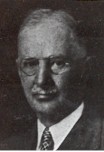Morris E. Leeds
Morris E. Leeds | |
|---|---|
 | |
| Born | March 6, 1869 |
| Died | February 8, 1952 (aged 82) |
| Nationality | American |
| Alma mater | University of Berlin Haverford College |
| Awards | ASME Medal (1946) IEE Edison Medal (1948) |
Morris E. Leeds (March 6, 1869 in Philadelphia – February 8, 1952) was an American electrical engineer known for his many inventions in the field of electrical measuring devices and controls.
Biography
Leeds was born in Philadelphia in 1869 to Barclay Robert and Mary (Maule) Leeds. After attending the Westtown School, he graduated with a B.S. at Haverford College in 1888. During 1892–93 he was a graduate student in physics at the University of Berlin.
After graduation in 1888 Leeds started work in industry. In 1903 he founded Leeds & Northrup Co. Philadelphia to manufacturer electrical instruments and optical pyrometers, where he was president until 1939 and chairman of the board of directors until 1952. His deeply held values, informed by his Quaker upbringing, informed his life both public and private.
Leeds was inducted into the Academy of Natural Sciences and American Academy of Political and Social Science. He received the Edward Longstreth Medal from the Franklin Institute in 1920,[1] the Henry Laurence Gantt Medal in 1936, the ASME Medal in 1946,[2] and the IEE Edison Medal in 1948.[3]
Patents

- US Patent No. 965.824 - recorder, 1910.
- US Patent No. 1.057.416 - speed control apparatus, 1913.
- US Patent No. 1.097.651 - measuring apparatus, 1914.
- US Patent No. 1.125.699 - electrical recorder, 1915.
- US Patent No. 1.192.911 - composite resistance, 1916.
- US Patent No. 1.332.182 - automatic control, 1917
References
- ^ "Franklin Laureate Database - Edward Longstreth Medal 1920 Laureates". Franklin Institute. Retrieved November 16, 2011.
- ^ "ASME Medal". American Society of Mechanical Engineers. Retrieved October 1, 2011.
- ^ "Morris E. Leeds". IEEE Global History Network. IEEE. Retrieved 25 July 2011.
